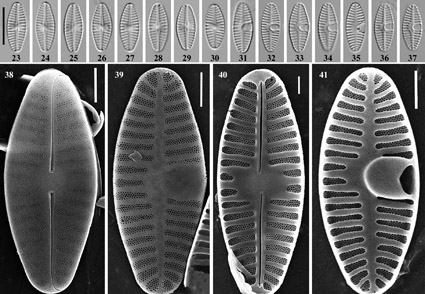Abstract
Two new species of the genus Planothidium isolated from a river and hot spring in the Kamchatka Peninsula, Russia, are described on the basis of morphological and molecular data. These are P. tyushovii sp. nov. and P. dyakonovii sp. nov. The new species are characterised by the presence of a covered depression in the centre of the rapheless valve (i.e., a cavum). Comparison of the new species with closely related taxa is given and the phylogenetic relationships of the Planothidium frequentissimum species group are discussed.
References
- Darriba, D., Taboada, G.L., Doallo, R. & Posada, D. (2012) jModelTest 2: More models, new heuristics and parallel computing. Nature Methods 9: 772. https://doi.org/10.1038/nmeth.2109
- Daugbjerg, N. & Andersen, R.A. (1997) A molecular phylogeny of the heterokont algae based on analyses of chloroplast-encoded rbcL sequence data. Journal of Phycology 33: 1031–1041.
- Drummond, A.J. & Rambaut, A. (2007) BEAST: Bayesian evolutionary analysis by sampling trees. BMC Ecology and Evolution 7: 214. https://doi.org/10.1186/1471-2148-7-214
- Guillard, R.R.L. & Lorenzen, C.J. (1972) Yellow-green algae with chlorophyllide c1,2. Journal of Phycology 8: 10–14.
- Jahn, R., Abarca, N., Gemeinholzer, B., Mora, D., Skibbe, O., Kulikovskiy, M., Gusev, E., Kusber, W.-H. & Zimmermann, J. (2017) Planothidium lanceolatum and Planothidium frequentissimum reinvestigated with molecular methods and morphology: four new species and the taxonomic importance of the sinus and cavum. Diatom Research 32 (1): 75–107. https://doi.org/10.1080/0269249X.2017.1312548
- Katoh, K. & Toh, H. (2010) Parallelization of the MAFFT multiple sequence alignment program. Bioinformatics 26: 1899–1900. https://doi.org/10.1093/bioinformatics/btq224
- Kumar, S., Stecher, G. & Tamura, K. (2016) MEGA7: Molecular Evolutionary Genetics Analysis Version 7.0 for Bigger Datasets. Molecular Biology and Evolution 33: 1870–1874. https://doi.org/10.1093/molbev/msw054
- Lange-Bertalot, H. (1993) 85 New Taxa and much more than 100 taxonomic clarifications supplementary to Süβwasserflora von Mitteleuropa Vol. 2/1–4. Bibliotheca Diatomologica 27: 1–164.
- Lange-Bertalot, H. (1999) Neue Kombinationen von Taxa aus Achnanthes Bory (sensu lato). Iconographia Diatomologica 6: 270–283.
- Marquardt, G.C., Bicudo, D.C., Bicudo, C.E.M., Ledru, M.-P., Ector, L. & Wetzel, C.E. (2021) Planothidium scrobiculatum sp. nov. (Bacillariophyta), a new monoraphid diatom from freshwater Pleistocene deposits of South America. Fottea 21 (1): 53–61. https://doi.org/10.5507/fot.2020.016
- Morales, E. (2006) Small Planothidium Round et Bukhtiyarova (Bacillariophyceae) taxa related to P. daui (Foged) Lange-Bertalot from the United States. Diatom Research 21 (2): 325–342. https://doi.org/10.1080/0269249X.2006.9705673
- Moss, M.O. & Carter, J.R. (1982) The resurrection of Achnanthes rostrata Østrup. Bacillaria 5: 157–164.
- N’Guessan, K.R., Wetzel, C.E. Ector, L., Coste, M., C.Cocquyt, C., Van de Vijver, B., Yao, S.S., Ouattara, A., Kouamelan, E.P. & Tison-Rosebery, J. (2014) Planothidium comperei sp. nov. (Bacillariophyta), a new diatom species from Ivory Coast. Plant Ecology and Evolution 147 (3): 455–462. https://doi.org/10.5091/plecevo.2014.981
- Novis, P.M., Braidwood, J. & Kilroy, C. (2012) Small diatoms (Bacillariophyta) in cultures from the Styx River, New Zealand, including descriptions of three new species. Phytotaxa 64: 11–45. https://doi.org/10.11646/phytotaxa.64.1.3
- Østrup, E. (1902) Freshwater diatoms. In Flora of Koh Chang. Part VII. Contributions to the knowledge of the Gulf of Siam. Preliminary Report on Botany, Results Danish Expedition to Siam (1899–1900). Botanisk Tidsskrift 25 (1): 28–41.
- Round, F.E. & Bukhtiyarova, L. (1996) Four new genera based on Achnanthes (Achnanthidium) together with a re-definition of Achnanthidium. Diatom Research 11 (2): 345–361. https://doi.org/10.1080/0269249X.1996.9705389
- Ruck, E.C. & Theriot, E.C. (2011) Origin and evolution of the canal raphe system in diatoms. Protist 162 (5): 723–737. https://doi.org/10.1016/j.protis.2011.02.003
- Stancheva, R. (2019) Planothidium sheathii, a new monoraphid diatom species from rivers in California, USA. Phytotaxa 393 (2): 131–140. https://doi.org/10.11646/phytotaxa.393.2.4
- Stamatakis, A., Hoover, P. & Rougemont, J. (2008) A Rapid Bootstrap Algorithm for the RAxML Web Servers. Systematic Biology 57: 758–771. https://doi.org/10.1080/10635150802429642
- Stancheva, R., Kristan, N.V., Kristan, W.B. III, & Sheath, R.G. (2020) Diatom genus Planothidium (Bacillariophyta) from streams and rivers in California, USA: diversity, distribution and autecology. Phytotaxa 470 (1): 1–30. https://doi.org/10.11646/phytotaxa.470.1.1
- Wetzel, C.E. & Ector, L. (2014) Taxonomy, distribution and autecology of Planothidium bagualensis sp. nov. (Bacillariophyta) a common monoraphid species from southern Brazilian rivers. Phytotaxa 156 (4): 201–210. https://doi.org/10.11646/phytotaxa.156.4.2
- Wetzel, C.E., Van de Vijver, B., Blanco, S. & Ector, L. (2019) On some common and new cavum-bearing Planothidium (Bacillariophyta) species from freshwater. Fottea 19 (1): 50–89. https://doi.org/10.5507/fot.2018.016
- Wetzel, C.E., Van De Vijver, B., Hoffmann, L. & Ector, L. (2013) Planothidium incuriatum sp. nov. a widely distributed diatom species (Bacillariophyta) and type analysis of Planothidium biporomum. Phytotaxa 138 (1): 43–57. https://doi.org/10.11646/phytotaxa.138.1.6
- Zimmermann, J., Abarca, N., Enk, N., Skibbe, O., Kusber, W.-H. & Jahn, R. (2014) Taxonomic reference libraries for environmental barcoding: a best practice example from diatom research. PLOS One 9 (9): 1–24. https://doi.org/10.1371/journal.pone.0108793
- Zimmermann, J., Jahn, R. & Gemeinholzer, B. (2011) Barcoding diatoms: Evaluation of the V4 subregion on the 18S rRNA gene, including new primers and protocols. Organisms Diversity & Evolution 11: 173–192. https://doi.org/10.1007/s13127-011-0050-6


